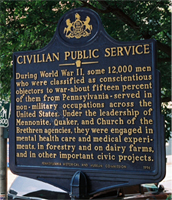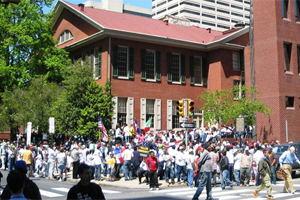Friends Center’s place in Philadelphia history began in 1856, when the Race Street Meetinghouse was built jointly by Philadelphia Yearly Meeting and what is now known as Central Philadelphia Monthly Meeting.
 The continuously active meetinghouse has served its congregation and the larger community for over 150 years. Important figures in the life of this building have included prominent women’s right activists Lucretia Mott, Hannah Clothier Hull, and Alice Paul. In 1993 the Race Street Meetinghouse was designated a National Historic Landmark for its role in women’s rights movement of the 19th and early 20th centuries.
The continuously active meetinghouse has served its congregation and the larger community for over 150 years. Important figures in the life of this building have included prominent women’s right activists Lucretia Mott, Hannah Clothier Hull, and Alice Paul. In 1993 the Race Street Meetinghouse was designated a National Historic Landmark for its role in women’s rights movement of the 19th and early 20th centuries.
In the early 1960s, a group of Friends responded to the long-stated wish to have a physical place where Quakers could gather for thought and action. Their response took the form of a plan for a dedicated campus, a Friends Center, where service organizations could be housed together to enable the synergies that come from physical proximity. The site they chose encorporates the Race Street Meetinghouse and its tree-filled courtyard. An adjacent 56,000 square foot office building was constructed in the early 1970s. The campus was dedicated as Friends Center in 1974.
 The Friends Center campus has been home to diverse groups working for peace and justice. The American Friends Service Committee, an international aid and development organization—recipient of the Nobel Peace Prize on behalf of Quakers worldwide—was founded here in 1917. Some prominent Philadelphia organizations such as Action AIDS and Women’s Way were welcomed as tenants at Friends Center when they were new and controversial. Friends Center currently houses nearly thirty tenant organizations.
The Friends Center campus has been home to diverse groups working for peace and justice. The American Friends Service Committee, an international aid and development organization—recipient of the Nobel Peace Prize on behalf of Quakers worldwide—was founded here in 1917. Some prominent Philadelphia organizations such as Action AIDS and Women’s Way were welcomed as tenants at Friends Center when they were new and controversial. Friends Center currently houses nearly thirty tenant organizations.
 In addition to serving as the home to a host of vital organizations, the campus has often been at the center of events in the city. The meetinghouse has hosted memorial services where friends and colleagues gathered in remembrance of prominent members of the government and city life. It was a refuge for protesters at the 2000 Republican National Convention. It continues today as an organizing place for peace and human rights and a stepping off place for marches and vigils. Friends Center has hosted difficult and sometimes fractious groups, realizing the space would encourage dialogue by providing an atmosphere of respect and peaceful problem solving.
In addition to serving as the home to a host of vital organizations, the campus has often been at the center of events in the city. The meetinghouse has hosted memorial services where friends and colleagues gathered in remembrance of prominent members of the government and city life. It was a refuge for protesters at the 2000 Republican National Convention. It continues today as an organizing place for peace and human rights and a stepping off place for marches and vigils. Friends Center has hosted difficult and sometimes fractious groups, realizing the space would encourage dialogue by providing an atmosphere of respect and peaceful problem solving.
In 2009 Friends Center completed a major renovation of its facilities. Recognizing that competition for water and energy resources are increasingly the source of war and conflict, Friends Center made a commitment to becoming a living witness for environmental responsibility. The LEED Platinum renovation created a campus that is fossil-fuel free, produces zero carbon emissions, and protects the watershed from stormwater runoff.
Friends Center is committed to preserving its historic past, and continuing to shape the future. It is a living landmark that seeks to serve Philadelphia and the world for generations to come.

